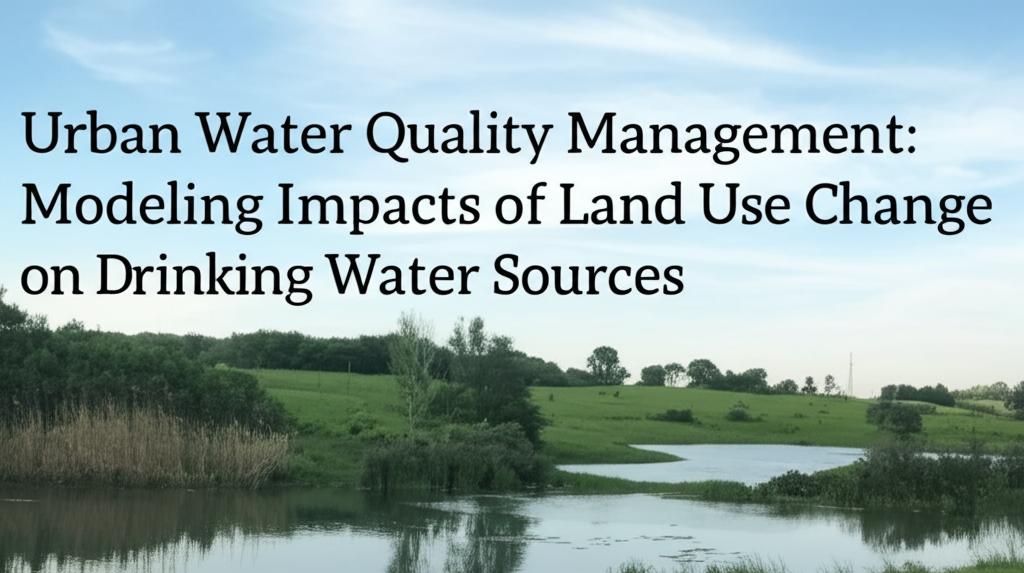Urban expansion and the conversion of natural landscapes are profound drivers of change in the quality of our drinking water sources. As cities grow, they significantly alter land surfaces, increasing impervious areas like roads and buildings. This transformation reduces the land's natural ability to absorb rainwater. Consequently, rainfall is more likely to become surface runoff, collecting pollutants as it flows across these modified landscapes and ultimately degrading the water quality in rivers, lakes, and groundwater aquifers that serve as drinking water supplies.
Modeling the Chain of ImpactUnderstanding and predicting how these land use changes affect water quality relies heavily on sophisticated modeling techniques. These models aim to simulate the complex interplay between land surface characteristics, hydrological processes, and pollutant transport.
- Increased Runoff and Pollutant Loads: Urbanization is consistently linked to higher volumes of surface runoff. This runoff often carries a cocktail of contaminants. In urban areas, common pollutants include sediment, nutrients (like nitrogen and phosphorus from fertilizers and waste), heavy metals, petroleum products from vehicles, and even pathogens. Agricultural land, another significant land use type, contributes pollutants such as pesticides, herbicides, excess nutrients from fertilizers, and animal waste.
- Impact on Water Treatment: The degradation of source water quality directly translates to increased challenges and costs for drinking water treatment. Water utilities may need to implement more complex and expensive treatment processes to remove these additional pollutants and ensure the water meets safety standards. Studies have shown a correlation between increased urban or agricultural land use in a watershed and higher operational costs for water treatment facilities. For instance, a 1% increase in urban land relative to forestland has been correlated with a 0.13% increase in annual variable treatment costs for surface water systems. For groundwater systems, a 1% increase in agricultural land relative to forestland has been linked to a 0.24% increase in costs.
- Forested Areas as Buffers: Conversely, forested lands play a crucial role in protecting water quality. Forests help filter pollutants, reduce erosion, stabilize streambanks, and promote groundwater recharge. The conversion of forested areas to urban or agricultural uses removes these natural protective functions, leading to a decline in source water quality. Research indicates that forest conservation, particularly upstream of drinking water intakes, is a vital strategy for safeguarding water supplies.
Several factors are critical in modeling the impact of land use change on water quality:
- Impervious Surfaces: The extent of impervious surfaces is a primary determinant of runoff volume and speed. Models often incorporate data on the percentage of impervious cover to estimate changes in hydrology.
- Soil Type and Topography: These characteristics influence infiltration rates, runoff pathways, and erosion potential.
- Vegetation Cover: Different types of vegetation have varying capacities to intercept rainfall, absorb nutrients, and stabilize soil.
- Proximity to Water Bodies: Land uses closer to rivers, streams, and wellheads tend to have a more direct and immediate impact on water quality. Riparian buffer zones (vegetated areas along waterways) are particularly important for filtering pollutants.
- Wastewater Management: In urban areas, the efficiency of wastewater collection and treatment systems is a major factor influencing the pollutant load discharged into receiving waters.
Researchers are continually developing and refining models to better capture these complex interactions.
- Hydrological Models: Tools like the Soil and Water Assessment Tool (SWAT) are widely used to simulate water flow, sediment transport, and nutrient cycling under different land use scenarios. These models can help predict changes in water yield, baseflow, and pollutant concentrations.
- Remote Sensing and GIS: Satellite imagery and Geographic Information Systems (GIS) are invaluable for mapping land use patterns, monitoring changes over time, and providing spatial data for models. Advancements in remote sensing, including high-resolution imagery and new sensor technologies, are enhancing the accuracy of land cover mapping and change detection.
- Integrated Modeling: Efforts are underway to integrate hydrological models with economic models and ecosystem service assessments. This allows for a more holistic understanding of the trade-offs associated with different land use decisions, including the economic costs of water quality degradation and the value of ecosystem services provided by natural landscapes.
- Low Impact Development (LID): Modeling is also used to evaluate the effectiveness of LID strategies, such as permeable pavements and bioretention areas (rain gardens), in mitigating the negative impacts of urbanization on runoff and water quality. Studies have shown that implementing LID techniques can significantly reduce runoff volume and pollutant loads.
- Climate Change: The impacts of land use change on water quality are often compounded by climate change. Changes in precipitation patterns, increased frequency of extreme weather events (droughts and floods), and rising temperatures can further exacerbate water quality problems. Future models will need to increasingly incorporate climate change projections.
- Data Scarcity: In many regions, particularly in developing countries, a lack of comprehensive and long-term water quality and land use data can hinder modeling efforts.
- Spatiotemporal Variability: Water quality can vary significantly over space and time. Capturing this variability in models remains a challenge.
- Policy and Management: A key goal of modeling is to provide actionable information for policymakers and water managers. This requires translating complex model outputs into clear insights that can inform land use planning, source water protection strategies, and infrastructure investments. Effective water resource management necessitates an integrated approach to land and water planning.
In conclusion, the shift towards urban and agricultural landscapes presents substantial threats to the quality of drinking water sources. Modeling these impacts is crucial for understanding the scope of the problem, predicting future changes, and developing effective management strategies. By simulating how different land uses affect hydrological processes and pollutant transport, these models empower communities to make more informed decisions to protect their vital water resources for the future. Continuous advancements in modeling techniques, coupled with improved data availability and a commitment to sustainable land use practices, are essential for ensuring safe and reliable drinking water in a rapidly urbanizing world.

